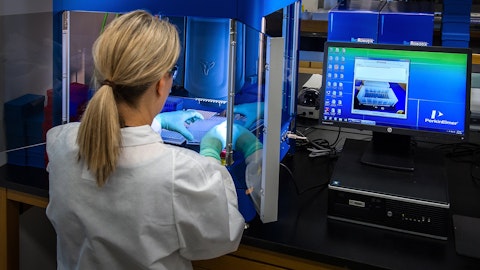Robert Musslewhite: Yes, if I can add, it sounds like a couple of the questions would assume that the CRPO effect and Rick’s comment about NDR, you’re taking those cumulatively, but those would be incorporated in whatever next year. So and Rick says that CRPO number, that’s the best indicator.
Glen Santangelo: Okay. Thanks very much.
Operator: And we’ll move next to Ryan MacDonald with Needham & Company.
Matt Shea: Hey, this is Matt Shea on for Ryan. Thanks for taking the questions. I wanted to follow-up on the commentary that you’ll be through about 80% of your ARR by March of 2024 next year and with Q4 being a big quarter for renewals and upsells. How does this Q4 maybe compared to last year and working through that 80%? Is this potentially more important Q4 than last year. And as you kind of head towards year-end, what kind of signs are giving you optimism or concerns around those Q4 sales activities?
Robert Musslewhite: So, Q4 is always a big quarter for us commercially, both in terms of new business and in terms of renewals. I think our second biggest renewal quarter is Q1. So, obviously, it’s a very important period ahead of us. I think what I’d say about that is our commentary is that the environment still feels kind of the same as we’ve seen it across this year. So, there are definitely some challenges in getting deals closed, both new business upsells and renewals. That said, we’ve now been operating in this environment for a while and had a lot of executional focus on how do you get what are really good top of funnel metrics down through the pipeline and close for our new business and upsell deals and how do we really focus on getting clients to renew and even expand their relationship with us.
Even when their environments are challenged. So, I guess my optimism is not necessarily because the environment feels different, but it’s because it feels like we’ve now had some time to really run these tactics and this focus through a lot more clients who are coming up for closing sales or closing renewals in the next two quarters. And I’m hopeful that, that work has been very good, and I’m hopeful that work yield some improvement.
Matt Shea: Got it. Appreciate that. And then I think the other sign of optimism really was the win back in the quarter, and so nice to see that win back. Curious if you could just comment on what drove that churn in the first place? And then ultimately, what drove them to come back? And then as you look out across the broader book of maybe customers that have walked away, do you see other win-back opportunities in the near to medium term pipeline?
Robert Musslewhite: Yes. And we always look for win back. I mean the dynamic that’s been going on in the market in general, this is generalizing, but we generally have a business user who is very engaged with us and what we’ve seen over the past 18 or so months is, in many cases, a buyer or a budget decision-maker, somewhere above that user has really tightened the reins and in some cases, has prevented the spend. And so I think that’s reflected in the fact where we still have really good top-of-funnel activity. We’re doing a record number of demos. People want to work with us. In general, they felt a lot more budget pressure and kind of organizational steps to get through to get things closed, and that’s what’s been playing out in our commercial performance.
So, for example, every quarter, we have some clients that have to make tough budget decisions and can’t stay with us as much as we try to keep them on board. In most cases, there’s someone on the other side who really wants to stick with us is being told no. Just like Rick is telling a bunch of people here, no external spend that’s happening in other organizations. So, when budget comes back, or when they’ve been able to work the processes internally, a lot of times, we’ll get the chance to get back in with those clients, and that’s what’s happened in that specific example on that. We see a few of those every quarter, and we certainly win someone churns and we know we have an engaged user we’ll stay after it. We don’t just forget about that client.
We stay after it, knowing that we’re going to have a chance to get back in when things turn for a little bit for the things turn in our favor.
Matt Shea: Great. Thanks guys.
Operator: And our next question will come from Joe Vruwink with Baird.
Joe Vruwink: Great. Hi everyone. I wanted to go quickly back to the CRPO commentary. So, I think loud and clear, that’s the best indicator that’s growing 7% right now. I guess just given the importance of 4Q and sales and renewals in 4Q, is it possible to put bounds around a 7% number and where you think CRPO ends up at year-end? And I don’t know if this is a good analog or not. But when I think about how you approach a revenue guide at the start of the year, there’s normally a 300 basis point range around that. So, would you may be bound to 7% by 300 basis points? Or how would you think about that?
Rick Booth: It’s a great observation about how we guide next quarter more formally for 2024. It’s really because Q4 does matter. And we’ve had divergent experiences across industry segments. So, I’m most comfortable sticking with what I’ve already said.
Joe Vruwink: Okay, fair enough. And then I was interested in the pro services anecdote because that was obviously a strong line item, and it seems like it was large client related. I guess, question one, does that have a subscription pull-through associated with it at some future point? And then part two of the question, is this type of services engagement, something you can maybe look to do more of just in the context that it seems you’re trying some new things. You mentioned customer success and engaging with our key clients. Is this maybe uncovering a potential opportunity that you could run more broadly in your customer base?
Rick Booth: I think our PS engagements really speak to the strength of our relationships, especially with large, large customers. They don’t necessarily have direct follow-on. But the more time that we spend with our customers, the more we understand their cutting-edge problems, the more we build that into the product in the long term, I would certainly hope for that.



